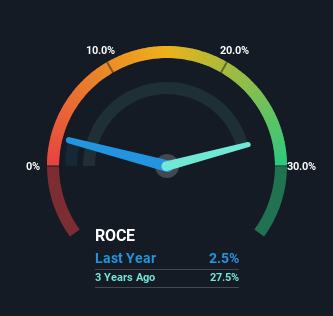Liaoning Xinde New Material Technology (SZSE:301349) May Have Issues Allocating Its Capital
Did you know there are some financial metrics that can provide clues of a potential multi-bagger? Firstly, we'd want to identify a growing return on capital employed (ROCE) and then alongside that, an ever-increasing base of capital employed. Basically this means that a company has profitable initiatives that it can continue to reinvest in, which is a trait of a compounding machine. However, after investigating Liaoning Xinde New Material Technology (SZSE:301349), we don't think it's current trends fit the mold of a multi-bagger.
Understanding Return On Capital Employed (ROCE)
Just to clarify if you're unsure, ROCE is a metric for evaluating how much pre-tax income (in percentage terms) a company earns on the capital invested in its business. The formula for this calculation on Liaoning Xinde New Material Technology is:
Return on Capital Employed = Earnings Before Interest and Tax (EBIT) ÷ (Total Assets - Current Liabilities)
0.025 = CN¥69m ÷ (CN¥3.1b - CN¥252m) (Based on the trailing twelve months to September 2023).
Therefore, Liaoning Xinde New Material Technology has an ROCE of 2.5%. Ultimately, that's a low return and it under-performs the Chemicals industry average of 5.7%.
View our latest analysis for Liaoning Xinde New Material Technology

Above you can see how the current ROCE for Liaoning Xinde New Material Technology compares to its prior returns on capital, but there's only so much you can tell from the past. If you'd like, you can check out the forecasts from the analysts covering Liaoning Xinde New Material Technology for free.
So How Is Liaoning Xinde New Material Technology's ROCE Trending?
When we looked at the ROCE trend at Liaoning Xinde New Material Technology, we didn't gain much confidence. Over the last four years, returns on capital have decreased to 2.5% from 32% four years ago. On the other hand, the company has been employing more capital without a corresponding improvement in sales in the last year, which could suggest these investments are longer term plays. It's worth keeping an eye on the company's earnings from here on to see if these investments do end up contributing to the bottom line.
On a related note, Liaoning Xinde New Material Technology has decreased its current liabilities to 8.2% of total assets. So we could link some of this to the decrease in ROCE. Effectively this means their suppliers or short-term creditors are funding less of the business, which reduces some elements of risk. Some would claim this reduces the business' efficiency at generating ROCE since it is now funding more of the operations with its own money.
What We Can Learn From Liaoning Xinde New Material Technology's ROCE
Bringing it all together, while we're somewhat encouraged by Liaoning Xinde New Material Technology's reinvestment in its own business, we're aware that returns are shrinking. Since the stock has declined 45% over the last year, investors may not be too optimistic on this trend improving either. On the whole, we aren't too inspired by the underlying trends and we think there may be better chances of finding a multi-bagger elsewhere.
On a final note, we found 4 warning signs for Liaoning Xinde New Material Technology (2 make us uncomfortable) you should be aware of.
For those who like to invest in solid companies, check out this free list of companies with solid balance sheets and high returns on equity.
New: AI Stock Screener & Alerts
Our new AI Stock Screener scans the market every day to uncover opportunities.
• Dividend Powerhouses (3%+ Yield)
• Undervalued Small Caps with Insider Buying
• High growth Tech and AI Companies
Or build your own from over 50 metrics.
Have feedback on this article? Concerned about the content? Get in touch with us directly. Alternatively, email editorial-team (at) simplywallst.com.
This article by Simply Wall St is general in nature. We provide commentary based on historical data and analyst forecasts only using an unbiased methodology and our articles are not intended to be financial advice. It does not constitute a recommendation to buy or sell any stock, and does not take account of your objectives, or your financial situation. We aim to bring you long-term focused analysis driven by fundamental data. Note that our analysis may not factor in the latest price-sensitive company announcements or qualitative material. Simply Wall St has no position in any stocks mentioned.
About SZSE:301349
Liaoning Xinde New Material Technology
Liaoning Xinde New Material Technology Co., Ltd.
High growth potential with mediocre balance sheet.
Market Insights
Community Narratives




